The latest vacancy data now mirrors pre-COVID figures following a “pandemic-height outlier,” according to New York State’s affordable housing agency. The number of empty apartments also matches the vacancy rate prior to landmark 2019 tenant protections that landlords blamed for the spike in empty units last year.
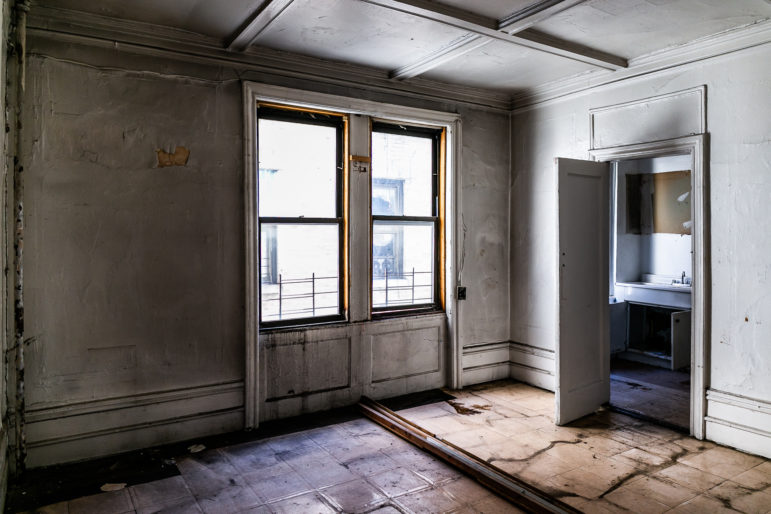
Adi Talwar
A vacant three-bedroom rent-stabilized apartment at 605 West 142nd Street.The number of empty rent-stabilized apartments in New York City dropped by nearly 50 percent over the past year, following a spike in vacancies early in the pandemic, according to new data from the state’s affordable housing agency. About one in every 10 empty units has been marked vacant for at least four consecutive years.
Property owners have registered 38,621 of the city’s roughly 1 million rent-stabilized units as vacant, according to the 2022 records provided by New York State Homes and Community Renewal (HCR). The updated data, based on the status of each registered apartment on April 1, adds new context to ongoing debates over how to unlock empty apartments—including an untold number of units deliberately “warehoused” by landlords—amid a housing crisis.
This year’s registration figure so far marks a significant decrease from the more than 61,000 vacancies tallied by HCR in 2021, as first reported by news site The City. Another report by The City, based on data from the Department of Housing Preservation and Development (HPD), put the vacancy number last year at close to 89,000 rent-stabilized apartments. That figure included units on the market and available to rent, as well as others held offline for a variety of reasons spelled out only in vague terms in the city’s record-keeping system, HPD said.
HCR’s latest tally now mirrors pre-COVID vacancy numbers following a “pandemic-height outlier,” said agency spokesperson Brian Butry. The vacancy rate also matches the number of empty apartments registered prior to landmark 2019 tenant protections that landlords have blamed for the rise in empty units last year.
In 2017 and 2018, about 39,000 regulated apartments were registered as vacant, according to HCR records. The number dropped to around 36,000 in 2019 and 33,600 in 2020 before spiking during the pandemic.
About 10 percent of the empty apartments tallied by HCR in April (around 3,800) have been registered as vacant every year since April 2019, the agency said. Another 3,200 units have been registered as vacant every year since 2020, but most were listed as empty for the first time this year, HCR added.
“Today’s conditions are not that of a year ago,” Butry said, referring to a time when wealthier New Yorkers had fled their apartments, including high-priced units subject to rent stabilization protections in buildings that receive 421a tax abatements. Those newer units differ from “traditional” rent-stabilized apartments, which are located in buildings with six or more units built before 1974, where legal rents are typically lower than market rates.
Most of the vacancies last year were in higher-rent units in larger buildings, HCR said, though the agency said it could not provide specific rent breakdowns on the empty apartments.
A May HCR memo to the Rent Guidelines Board with borough-by-borough vacancy numbers from 2021 showed 27,645 empty rent-stabilized apartments in Manhattan priced at an average of $4,144—far higher than the average legal rent of $2,064 across all of the borough’s rent-stabilized units. Manhattan’s vacancy rate more than doubled from April 1, 2020 to April 1, 2021, according to the memo first reported by The City.
Those more expensive empty apartments fit the profile of the pads that wealthier New Yorkers ditched early in the pandemic before returning to the city and waging bidding wars in the trendiest zip codes, said Legal Aid Society Staff Attorney Ellen Davidson. A report last year from the City Comptroller’s Office based on change of address forms found that New Yorkers fled higher-income neighborhoods in the spring of 2020 before residents returned en masse in the summer of 2021—after HCR’s registrations that year.
But there are several limits to the point-in-time data. More units may have become vacant since the April 1 registrations, while many vacant units may now be leased-up and occupied, Davidson said.
“We don’t know what’s happened to them,” she said. “They could have been leased in the past few months for all we know.”
A fair number of rent-stabilized units have not been registered at all, meaning their status is unclear, said Larry Wood, director of advocacy and organizing at Goddard Riverside. HCR said landlords have so far registered around 850,000 apartments this year, down from around 928,000 in 2019. Many owners end up updating the agency late, while some fail to notify HCR.
“It’s what the landlords are choosing to report,” Wood said.
How many ‘warehoused’ units? Who knows
With New York City mired in decades-long affordability and homelessness crises, and rents reaching record highs, vacant regulated apartments have emerged as a major target in the effort to unlock housing for low- and middle-income New Yorkers. Under state law, landlords of rent-stabilized apartments can only raise monthly rates by a modest percentage set each year by the city’s Rent Guidelines Board—most recently, 3.25 percent on one-year leases.
Bulk vacancy data from the city and state have fueled political debates about how best to open up the empty apartments. Landlord groups assail the 2019 renter protections known as the Housing Stability and Tenant Protection Act (HSTPA), while tenants urge the city and state to penalize property owners who deliberately keep their apartments off the market—a practice known as “warehousing.”
Prior to the HSTPA , landlords could permanently lift units out of regulation after rents reached a certain threshold—greased by allowable hikes to cover renovation costs and a so-called “vacancy bonus” that allowed owners to raise rent by 20 percent on empty units. Those rules incentivized many speculators to purchase buildings with the goal of deregulating units—at times, by any means necessary. Some landlords committed fraud to juice the cost of renovations and harassed tenants to drive them out and deregulate the apartments. HSTPA eliminated those incentives, though some loopholes still allow landlords to increase base rents.
But landlord groups contend that since those 2019 changes, many property owners cannot afford to renovate empty rent-stabilized apartments or have chosen not to rent them under current price restrictions. They are seeking changes to the rent laws and say owners could reintroduce tens of thousands of units to the market if they are allowed to raise rents. They have launched a social media campaign highlighting particularly egregious conditions in vacant apartments that they say demand costly repairs.
“This is not a conspiracy theory, this is basic math,” said Jay Martin, director of the rent-stabilized landlord group Community Housing Improvement Program (CHIP). “The majority of vacant rent-stabilized apartments need massive renovations in order to be lead-safe, energy-efficient, and up to code with new building standards. This costs a lot of money, and in many of these units the rents are already below the operating cost.”
Few have formally claimed financial hardship, however. HCR allows owners to apply for a rent adjustment if they are in financial trouble. HCR said they have received six hardship applications from landlords since 2019 and granted none of them.
An analysis of 2020 data by the Rent Guidelines Board also found that apartments in buildings with rent-stabilized units generated $545 per month, enough that “revenues exceed operating costs in nearly all buildings, yielding funds that can be used for mortgage payments, improvements and/or pretax profit.” The RGB will not consider 2022 data for another two years.
At the same time, the number of registered vacancies this year matched the figure in 2017 and 2018, before HSTPA took effect. Sam Stein, a housing policy analyst with the Community Service Society (a City Limits funder), said those similar vacancy counts undermine claims that the rent laws have made property ownership unprofitable.
“If the number is the same as it was before HSTPA then it makes no sense to say HSTPA is the thing causing the vacancies,” Stein said.
Stein is among the advocates, elected officials and housing experts urging the city to provide more consistent and specific information on vacancies to identify the true extent of the warehousing problem and affect more informed policy decisions.
While examples abound, no one quite knows how many apartments are being “warehoused.”
Several housing experts interviewed for this story said apartments held off the market for multiple consecutive years—like the 3,800 since 2019 and 3,200 since 2020—could be warehoused, but even then, the numbers demand more analysis.
“The thing missing is a real discussion about the different kinds of vacancies that could be reported,” said Rafael Cestero, the CEO of Community Preservation Corporation (CPC) and a former HPD commissioner. “Not every vacancy is the same.”
A spokesperson for HPD said some number of vacant units may be intentionally held off the market, but the agency does not consider that the case for the vast majority of empty rent-stabilized apartments.
In the absence of official state or city data, tenant groups have compiled their own counts and examples.
The End Apartment Warehousing Coalition, made up of tenant associations and advocacy groups from across the city, have honed in on rent-stabilized vacancies in wealthy areas, like the Upper West Side, and rapidly gentrifying neighborhoods, like Williamsburg, Bushwick and Harlem. There, they say, owners are more likely to hold units off the market to eventually demolish a building or legally combine multiple units and set a new higher base rent—a practice known as “Frankensteining.”
“It’s an on-the-ground tabulation,” said Colin Kent-Daggett, a senior community organizer with St. Nick’s Alliance and a member of the End Apartment Warehousing Coalition. “Door by door surveys, and that’s how we’ve been able to find patterns of intentional warehousing.”
HCR has proposed eliminating "Frankensteining" by stopping owners from setting a new monthly rent at whatever price they want after they combine stabilized units. Instead, the new rules would force them to base the new price on the sum of the past rents plus a percentage of renovation costs.
A report released Tuesday by the End Apartment Warehousing Coalition documented three examples of landlords holding units off the market and combining empty apartments to set higher rents. At one apartment building on East 26th Street, the property owner reduced the number of units from 89 to 72 after clearing out about half the tenants and combining some apartments, the report states. On the Upper West Side, a property owner has fused several adjacent rent-stabilized units and stopped registering its regulated units with HCR, the report adds.
Still, Kent-Daggett said, not every empty apartment is “warehoused.”
“There are vacancies for any number of reasons: sometimes it’s an older landlord who cannot make renovations, sometimes it’s intentional, sometimes it’s a natural gap between tenants,” he said.
Cea Weaver, an organizer with the Housing Justice For All Coalition, agreed that most deliberate warehousing occurs “in places with the most intense gentrification pressures in the city.” Empty apartments in lower-income areas, by contrast, may be the result of landlord negligence or absenteeism, she said.
Weaver said the warehousing debate, without hard data, can distract from broader housing goals, like stronger rent subsidies and tenant protections in unregulated apartments. “It becomes a political play without clarity around the real number, and the different numbers on why apartments will be held vacant,” she said.
Empty apartments can have a significant impact on neighboring residents, however. At one building on Menahan Street in Bushwick that City Limits visited in March, rats had invaded a vacant ground-floor unit, leaving behind a carpet of feces and making their way into other tenants’ homes.
“I feel desperate,” first-floor tenant Gabriela Velazquez told City Limits in Spanish at the time. “I live here and I don’t want to leave, but it’s causing respiratory problems.”
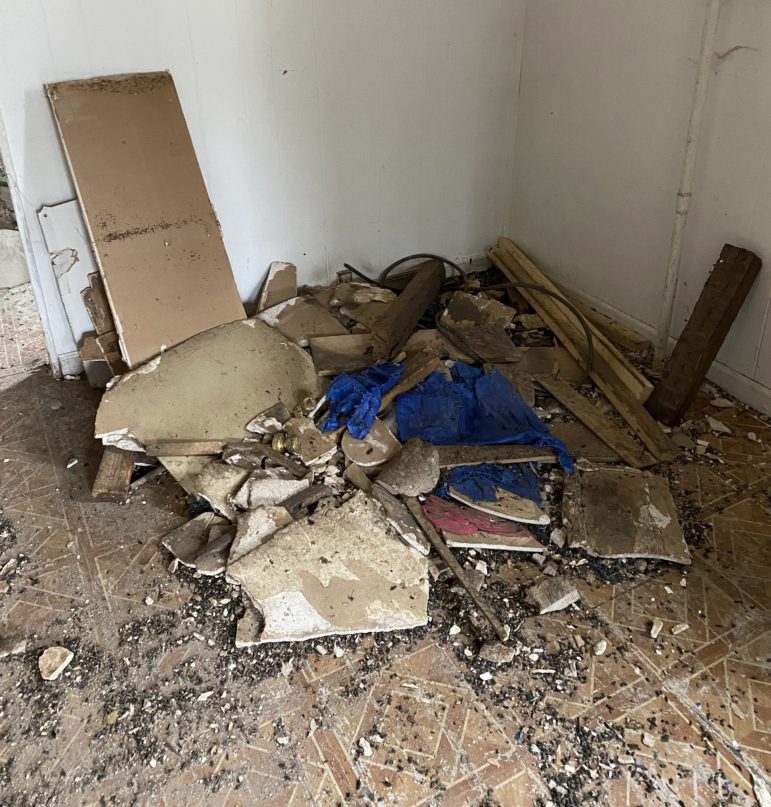
David Brand
Debris and rat feces litter the floor of a vacant first-floor apartment owned by a private equity firm on Menahan Street in Bushwick.The private equity firm that owns the building, Hirshmark Capital, and the management company Wayfinder did not respond to requests for comment.
At a rally against warehousing outside City Hall earlier this month, Williamsburg resident Silo Espinal described how his landlords tore apart a unit after it became vacant and removed insulation from the wall. “He's gutted their apartments, destroyed their apartments for seemingly no reason,” Espinal said. “If It's 40, 30 degrees we'll start to get frost.”
A bill introduced by Councilmember Carlina Rivera could shed light on the true number of apartments being deliberately held offline while improving conditions for other residents, like the Bushwick and Williamsburg tenants. The bill, Intro. 0195, would require owners to register all vacant apartments with HPD annually and force the housing agency to inspect at least 15 percent of those empty units.
“It's gotten to the point where we've seen conditions that are just really unacceptable. And the whole building suffers,” Rivera told City Limits.
She said the measures would increase accountability for absentee landlords, like the large real estate firms operating under opaque LLCs. “They’re not even present in the city,” she said. “So it's hard to even talk to them and have direct conversations let alone for the tenants to try to fight for satisfactory conditions.”
In recent weeks, City Limits has visited various vacant rent-stabilized units, but the reasons they are empty are not immediately clear, even to tenants living nearby. Inside a Chelsea co-op building with three rent-stabilized apartments, a second-floor unit sits empty, its door weathered, its peep hole covered in blue tape and its number removed. The person listed as the head officer for the limited liability owner hung up when asked about the unit.
At two adjoining, century-old walk-ups in Long Island City, 12 of 46 apartments are padlocked. A representative for the firm that owns the buildings, Peak Capital, said they are renovating the units and planning to re-open them. Just one is rent-stabilized, he said, adding that the company is waiting to see if HCR’s laws related to “Frankensteining” change before deciding to put that unit back on the market.
The city’s most recent Housing and Vacancy Survey (HVS), a triennial analysis of New York City’s housing stock, found that 42,860 rent-stabilized units were considered vacant and unavailable in 2021.
The HVS is also used to determine the overall apartment vacancy rate in New York City. A vacancy rate below 5 percent is considered a “housing emergency,” triggering the continuation of the city’s rent stabilization laws. The most recent survey, conducted between February and July 2021, found that 4.5 percent of New York City’s roughly 2.3 million apartments were vacant and available for rent last year, including less than 1 percent of all units priced below $1,500 per month.
In that context, with hundreds of thousands of low-income New Yorkers in need of an affordable home, “even one warehoused unit is one too many,” said Wood, of Goddard Riverside.
Leading landlord groups, meanwhile, have pushed back against the idea that warehousing is a coordinated effort among property owners. While they want state lawmakers—or the U.S. Supreme Court—to overturn the 2019 rent laws, they say landlords who hoard units in an attempt to skirt regulations do not represent most property owners.

Adi Talwar
A room near the entrance to a vacant fifth-floor apartment at 605 West 142nd St. in HarlemDuring a tour of a vacant rent-stabilized three-bedroom apartment on West 142nd Street, Martin, the head of CHIP, and building owner Ken Gerstenfeld bristled at the “warehousing” characterization.
“A very small portion are [owners of] these long-term unoccupied [units] who are attempting to maybe deregulate or do full tear-downs,” Martin said.
He said CHIP members who leave their rent-stabilized units vacant determine that “the math is completely upside down,” meaning the renovation costs are not worth the limited potential income.
Gerstenfeld said the apartment, located on the fifth-floor of an elevator building with a mix of regulated and market-rate units, has a legal rent capped at around $850 per month. He said he was unable to make ongoing renovations because the previous tenant blocked access to the unit. He estimated that removing lead paint, covering exposed pipes and redoing floors, ceilings and walls in the large apartment could cost him six figures.
Gerstenfeld, whose company owns 100 units in multiple buildings, said it’s not worth doing the work since he cannot raise the rent to make up that cost under the current laws.
CHIP has said there are 20,000 apartments like that and proposes a vacancy reset that allows landlords to raise the rent on empty apartments. The organization shared an itemized list of expenses for renovations in another rent-stabilized one-bedroom apartment. Not including labor and insurance, the project cost just under $53,400, the invoice shows. Meanwhile, the price of materials and heating oil are on the rise, and owners still have to pay their mortgages and property taxes.
But landlords are not required to open their books to detail their potential expenses if the apartment is off the market. Without more comprehensive audits by the city or state, it may be impossible to know how many owners are withholding apartments because they cannot afford upkeep or because they determine that renting them out would generate too little income, said Stein, from the Community Service Society.
He also said the claims about massive renovation costs raise concerns about conditions for the most recent residents.
“If they’re saying the units are uninhabitable now, then what was it like for the last tenants?” he said.
CHIP countered that rules have changed significantly over the past few decades and that owners must do significant renovation work to comply with the new code when a unit becomes vacant, particularly around lead remediation.
To Ismene Speliotis, executive director of the nonprofit Mutual Housing Association of New York, every vacant unit is different and the costs of renovation vary.
Speliotis, whose organization owns and manages hundreds of rent-stabilized apartments, said some units can indeed cost tens of thousands of dollars to renovate, while others tend to set the landlord back a few grand in routine maintenance.
She said some landlords no doubt do face tough financial times, but others simply withhold apartments with the goal of raising rents or deregulating them down the road.
“I think on that spectrum there are people who want to rent them, people who don’t have the money [for renovations], and then people hoarding because they hope rules change in Albany,” she said. “There are so many permutations of what the nuances are and they all matter.”


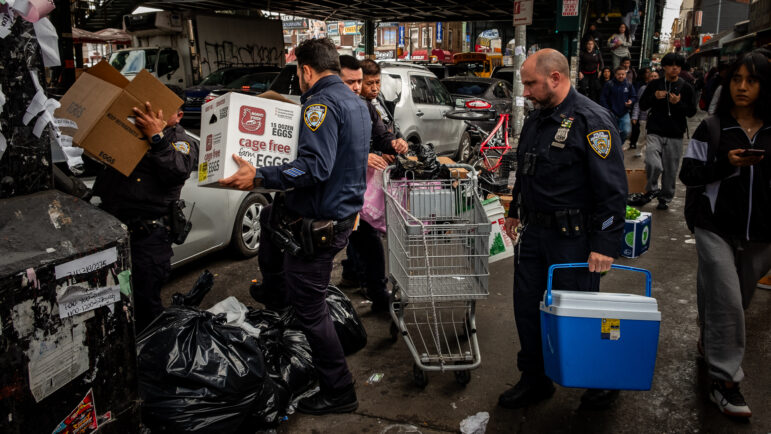
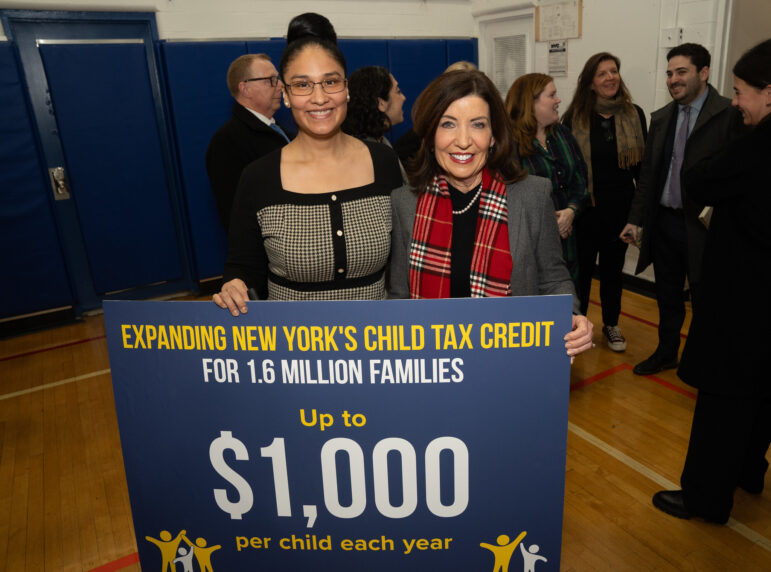
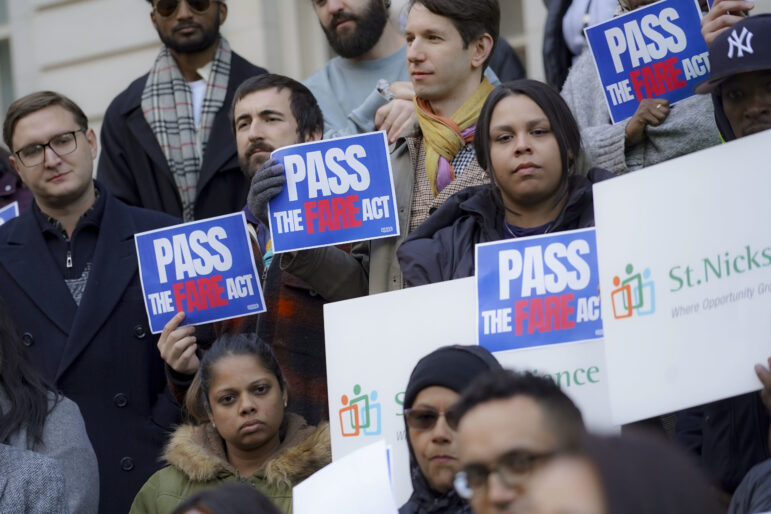

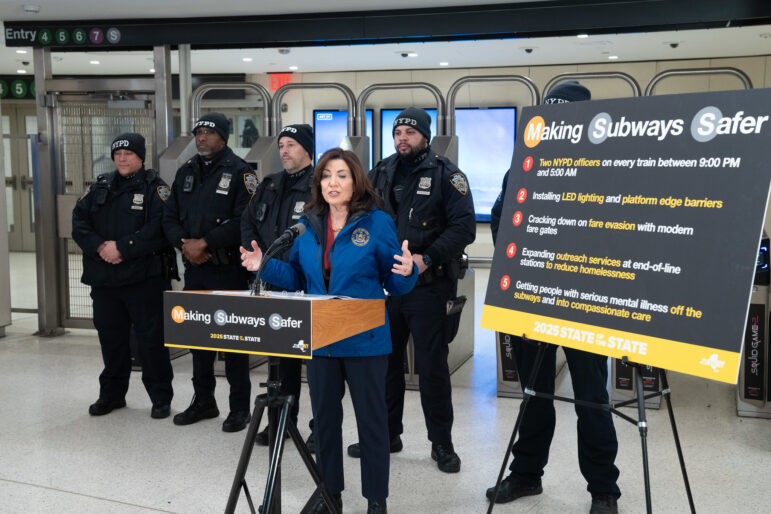


8 thoughts on “Empty Rent-Stabilized Units in NYC Decreased This Year, as ‘Warehousing’ Debate Rages”
The average legal rent of over $2k is a ridiculous stat. It obviously includes 421 A buildings which skews the data.
It’s remarkably disingenuous to use that number.
Reach out to the Furman Cent. I bet they’ll tell you that more than half of all rent stabilized units rent for less than $1,400/month.
PS – I know of over 30 buildings in Northern Manhattan where landlords have stopped paying the mortgage in the last two months. They are walking away from their buildings and losing tens of millions of dollars. The 2019 rules don’t work.
And…the hardship rules are a joke. They take years, cost tens of thousands of dollars, and then you get denied.
Foreclosures are just beginning. The far left thinks it’s funny, but these are families losing their life savings. And now these tenants are in trouble. You don’t want to live in a building in foreclosure.
Thank you for this article.
The 2019 HSTPA didn’t cause warehousing: it’s been an issue for decades. So weakening the law will not solve the problem.
Getting accurate data will help get to solutions. City Council bills proposed by Carlina Rivera, Gale Brewer, and Lincoln Restler will help, as well a state bill proposed by Assembly Member Linda Rosenthal.
If most of the warehoused rent-stabilized units are higher-cost , they’re likely in buildings getting tax breaks (421A or J-51, for example). The state can act on that.
On the assertion that too much money is needed to bring empty stabilized units up to habitability (and rentability) : it is unlikely that the majority of tenants in the 38,000 units cited were both happy to live in squalor and barred landlord access for maintenance. Landlords have remedies for that just as they have for rents that don’t provide them with state-recognized profit.
Finally, the Coalition to End Apartment Warehousing’s report (https://bit.ly/EndWarehousingReportNov22), to which I contributed, cites issues in 13 buildings – not all of them wealthy or on the Upper West Side.
so what are the politicians that we put in office doing, nothing, while tenants are losing there apartments, others wait on long waiting lists for affordablehousing, and there are 80,000 vacant rentstabilized collecting dust, NY NY
2019 Law is disastrous for the Tenants it was supposed to help. Housing in NYC will become a corporate takeover. Mom and Pop landlords who for the most part care about the buildings and the families that have resided there for years are the ones losing their wealth. Instead of attacking the owners, why not find a way to make the math work if they keep the buildings stabilized by at least a certain percentage? Can be done through tax breaks, energy rebates, etc. No one wants to deal with this class of tenant, especially the City. But the current system is not sustainable.
😳 omg buffalo, ny is almost just as bad. Yeah they’re bldg apts they claim is affordable, well tenants hvin to pay lights, and gas, is not wht u call affordable housing. Hw??? Hw is it that the mayor wnts to eventually make this a predominant electric run city,well this new affordable housing market is trash. They dnt think about the ppl who r empty nesters. Those of us with out kids at home,gets dumped on. (if u knw wht i mean by dumped on,then u followin wht im sayin). Its alot of senior’s,middle aged,n homeless ppl who would,n could benefit frm “Real” affordable housing here in buffalo, ny.
What actually is affordable housing in NYC? There needs to be a clearer picture to define what that means. In the fifty’s NYCHA had a list of what complexes you could apply to based on income low, middle and high. Now every apartment is on the higher end of the spectrum. There are a lot of hard working people who need housing but can’t find an apartment that fits there budget. Landlords and corporations that hang on to apartments to receive special subsidies for taking in refugees is not fair. Some type of program should be established to help our residents who need a leg up to live decently instead of having to flee the city that the love. Why can’t clear heads prevail here? A person who works and has a disability on a fixed income is forced to live as a couch surfer from home to home of friends and family. I am sure we can do better than this . Let’s all come together to work out a suitable solution for our future.
Throughout Manhattan – especially the Upper East Side – there have been and continue to be a ton of new luxury high-rise buildings going up encompassing entire blocks!
All these new buildings replaced older 5 story walk-up buildings. Developers snapped up the old buildings and warehoused apartments – for years – until able to tear down .
If there are fewer warehoused apartments, it is probably because Big Real Estate already destroyed so many.